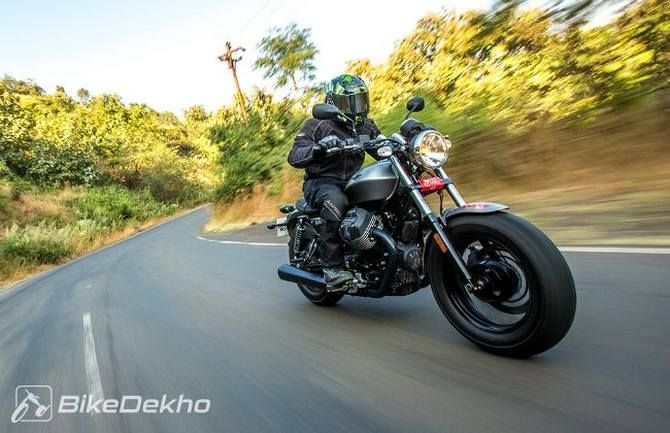 The Moto Guzzi V9 Bobber, priced at Rs 14 lakh, the V9 Bobber is an expensive proposition but don't discount it yet. BikeDekho reviews the latest Italian bike from one of the oldest surviving motorcycle brands in the world.
The Moto Guzzi V9 Bobber, priced at Rs 14 lakh, the V9 Bobber is an expensive proposition but don't discount it yet. BikeDekho reviews the latest Italian bike from one of the oldest surviving motorcycle brands in the world.

"For Rs 14 lakh, won't you get the Suzuki Hayabusa?" argued my colleague Arun. The recent price cut puts the hyperbike within the reach of someone with Rs 14 lakh to spare but then the Peregrine Falcon and the Italian Eagle are worlds apart and cater to different motorcycling cultures. And both deliver an equally engaging riding experience; in their own way.
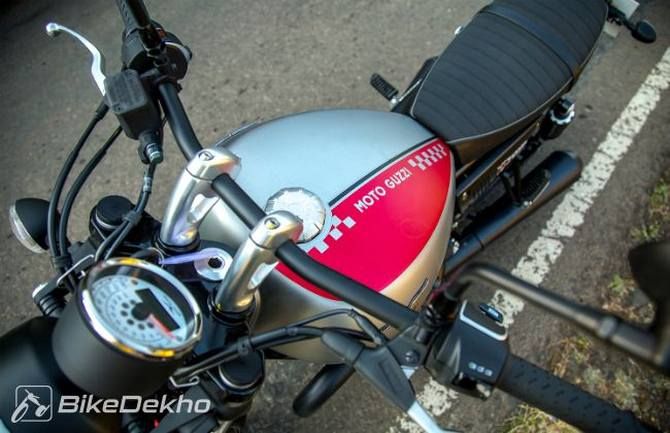
Both of us have been racking our brains to find the definitive customer who would go for such a bike. A connoisseur, perhaps?
An informed, well-off biker looking for his fourth set of wheels (s/he already has a KTM Duke 390, Triumph Tiger 800 and a Ducati 959 in his stable). He wants something as comfortable as a cruiser but not the lazy dynamics associated with one.
He wants something exotica with a dash of retro; something that can set the tone for late evening conversations.
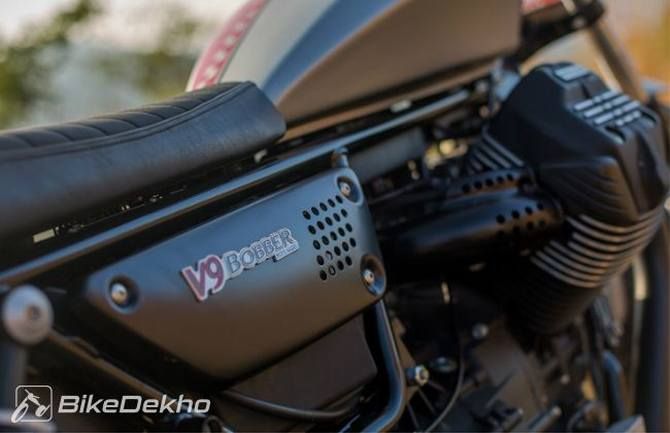
Conversations that can start with Moto Guzzi -- one of the oldest surviving motorcycle brands in the world. The Italian bike maker started building motorcycles in 1921 in Mandello Del Lario -- a quaint town located on the banks of Lake Como, a place where all Moto Guzzi bikes are still manufactured.
Though Moto Guzzis might be known for their longitudinally mounted V-twin motors, their first bike neither had the longitudinal engine layout nor was a V-twin.
In fact, it was a chain-driven single.
It wasn't until 1967 that the Moto Guzzi's trademark longitudinally mounted V-twin was launched in the form of the V7. The bike you see here has the V9 engine derived from the 1967 V7, but with a slew of improvements towards refinement and performance.
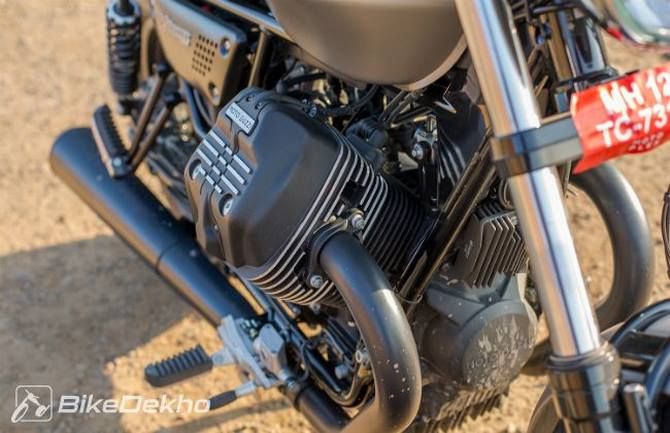
The obvious benefits of such a layout is that you have two cylinders sticking out of the body and into the open, so you have to worry less about the motor heating once on the move. This allows designers to keep the motor air-cooled, though the V9 motor also benefits from oil cooling.
Engine packaging is easier since the gearbox housing sits longitudinally right behind the engine and is connected to a shaft-driven rear wheel.
The clutch unit is a single plate dry clutch, much like a car, and has a surprisingly silent clutch operation.
The shaft drive means negligible mechanical losses in transmitting power to the rear wheel. One disadvantage of such a layout is the torque reaction -- the side rocking motion felt when you accelerate.
This is due to the crankshaft rotation and is a common trait on bikes having longitudinally mounted shaft-driven engines like the Triumph Rocket III and the BMW Boxer twins. This posed a problem on earlier bikes in the cornering department but with the addition of a balancer shaft, the problem is now relegated to a mild characteristic of the engine.
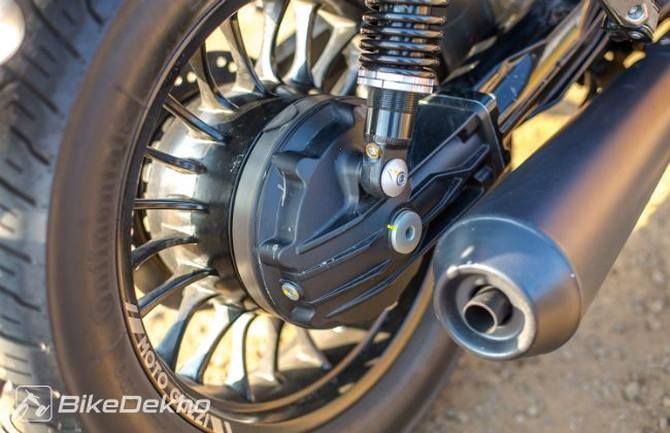
The 865cc V-twin motor on the V9 Bobber is tuned more for refinement and rideability than outright performance. The slightly over-square motor puts out a modest 55PS at 6250rpm and 62Nm of torque at 3000rpm, with over 80 per cent available from 2000rpm all the way to the redline.
The result is a thick and flat torque curve that can be used in any riding conditions.
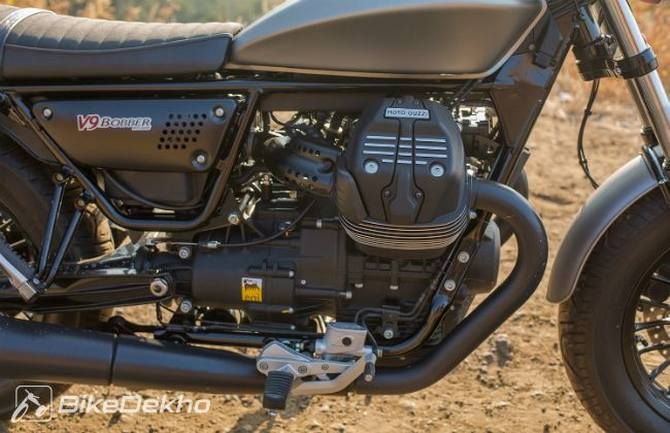
Fuel efficiency as tested for the Moto Guzzi V9 Bobber is 18.22kmpl in the city and 24.63kmpl on the highway. That combined with the 15-litre fuel tank should give you a touring range of around 270 to 370 kilometres.
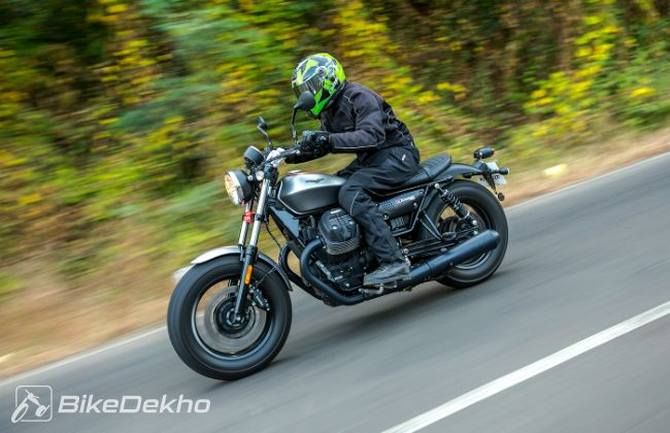
Thumb the starter and the V-twin comes to life with the bike nodding to the right, an idiosyncrasy that can be felt only during start-ups, at idle, and during sudden acceleration. It is nothing to be bothered about; just a unique flavour of the bike to enjoy.
Once started, the motor settles down in a soft staccato idle thanks to twin two-into-two exhaust pipes. The bike runs too muted for a V-twin and if you buy this bike, a set of louder pipes is something you should look into.
Or you could revel in the refinement that is quite uncharacteristic of a V-twin.
Despite the mid-sized V-twin, this is quite an easy bike to ride and a hoot at low-city speeds. The engine has a fair sense of urgency but is never over the top, even at high revs. This, I think, is due to the flat torque band. The clutch, too, is light and easy to modulate at low speeds without you having a brown pants moment, a quality very few mid capacity bikes possess.
The six-speed short-ratio gearbox is precise but misses the snickety action of Japanese bikes.
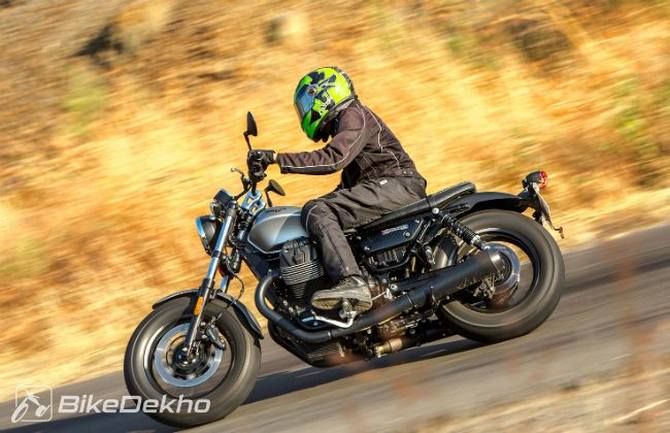
The bike is equipped with a two-stage traction control -- for wet and dry operation. It isn't the most refined unit I have seen and makes the bike lurch at low throttle openings at less than perfect road conditions. Thankfully you can switch off traction control and most of the time you don't need it anyway.
This is a bike that will intimidate noobs at first but then also a bike they will get used to with ease. It's not just a bike for beginners, though. The engine does mildly excite but there are other areas where the V9 Bobber will keep the seasoned lot satiated. Areas like dynamics, where the Bobber feels quite accomplished.
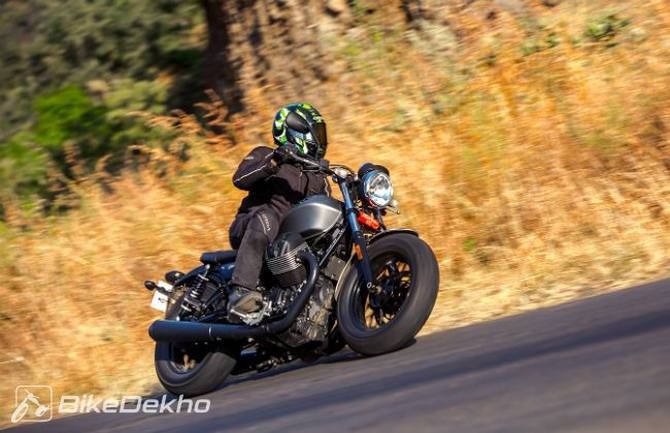
Now, the closest competition I can see for the V9 Bobber in terms of ease of use, performance and dynamics is the Triumph Street Twin. On paper, the Street Twin promises sharper handling with a shorter wheelbase and a sharper rake but on the road, the V9 Bobber feels more engaging and impresses with its grip levels that increases your confidence levels on the bike and will have you scraping the hero blobs at every possible opportunity.
The riding position with the flatter seat and dragster handlebar has you mildly canted forward and lets you move around. The bars feel a bit heavy due to the fatter front tyre, but feel quite engaging.
The motor contributes with its immense flexibility from 2000rpm all the way to the 7000rpm redline. The brakes are a simple set up with a single 320mm front and 260mm rear discs, clamped by Brembo callipers.
The front brake has excellent initial bite and feel, though the rear could do with a bit more of both. ABS is standard and cuts in late, stepping in only when things get hairy.
ABS cannot be switched off, not that I see a reason to do so here. The Continental touring-spec tyres provide excellent grip despite the higher profile. Lateral grip during braking is impressive and the bike displays exemplary composure, coming to a dead stop from high speeds.
Riding in the city is a surprisingly easy affair. Surprising because you do not expect a bike of this size to be as easy to manoeuvre as a Ducati Scrambler. Turning radius is excellent and despite the 200kg kerb weight, the bike is quite easy to manage in traffic.
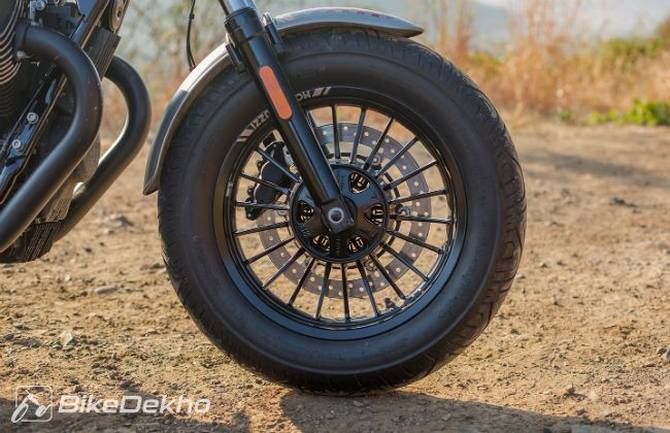
The V9 Bobber's suspension has been tuned for a softer set up and while the front forks soak up most road imperfections, the rear twin dampers seem to run out of travel. This poses a problem at high speeds where the rear tends to bottom out and hop, sometimes transmitting jolts up the rider's spine.
There are two styles to choose from -- the Bobber and the Roamer. While the Roamer is the more affordable and touring oriented of the two, the Bobber is the more colourful of the two.
The Bobber styling is a hark back to the 30s where, influenced by the AMA races which predominantly saw the Indian Scout Sixty and Harley XR being raced, bikers began to modify their machines themselves, stripping them down for performance.
The term 'garage-built' best exemplifies the Moto Guzzi V9 Bobber, with its clean paint job and straight lines. Bobber styling comes in the form of those chunky tyres, a flat seat and chopped fenders.
The minimalist design lets you focus on the engine, whose uniqueness would otherwise be lost in excess bodywork. The tank may look like a simple unit but features complex surfaces and lines and narrows down to the back so that the rider does not have to spread her/his legs.
The top half features a decal to eliminate visual boredom while the rest is a high quality painted affair. The headlamp design, though, could be better executed. Similarly, the tail lamp looks like an afterthought in the design process.
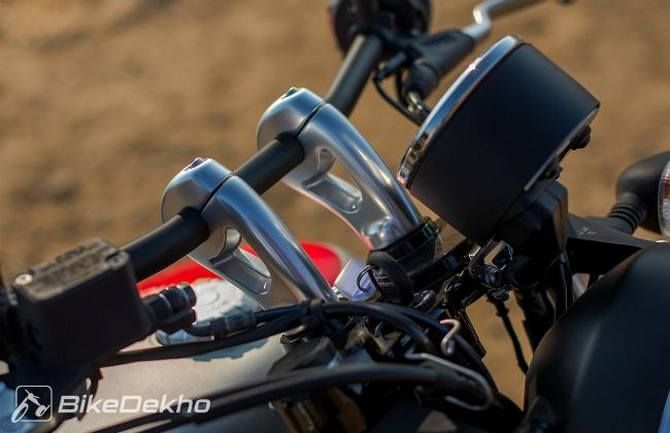
Look closely and you will appreciate the attention to detail. Like the cast aluminium fuel cap, handlebar mounts and rear brake lever assembly that have been machined to give a smooth finish.
The switchgear is a tactile delight and easily the best we have sampled so far.

The instrument console is a large analogue affair with a cluster of warning lights concentrated at the centre. There is a digital display at the bottom that shows fuel efficiency, outside air temperature and gear position but misses out on a tachometer.
Well, Moto Guzzi does have a smartphone app that links to the bike via Bluetooth and shows a host of relevant information including engine revs, lean angle and navigation.
It also has a tab called 'The Nest' that shows the distance between you and the Moto Guzzi factory in Mandello Del Lario. You do require a handlebar mount for the smartphone, something the dealer will have shipped for you or you could check out some aftermarket units available online.
The seat has a suede leather feel and is flat and wide though taking a pillion along is a rather uncomfortable affair. Despite the lack of contouring, it is good enough to sit on for a 100 kilometre stretch.
The Bobber isn't meant for touring but is more than up for the occasional weekend trip though the lack of bungee hooks feels like an oversight and the short seat does not help either.
There is a rear rack on the Moto Guzzi catalogue that you can look into.
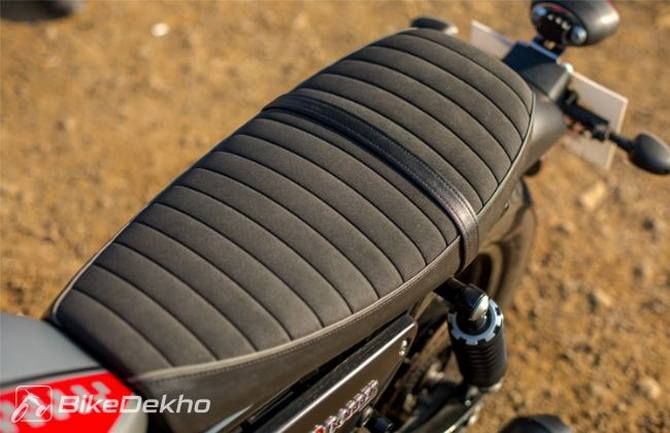
The question remains: is the Moto Guzzi V9 Bobber worth the Rs 13.9 lakh (ex-showroom, Pune) asking price? The high price is due to the bike being brought to India as a CBU (completely built unit). There are quite a few options to choose from, like the Triumph Street Twin, Ducati Scrambler and the Indian Scout Sixty.
These offer sprightlier performance but miss out on the unique feel of the longitudinally mounted V-twin.
And Moto Guzzis are one of the most unique motorcycles you can get your hands on in India.
The V9 Bobber offers a lot in terms of rider engagement, refinement and the absolute flexibility that makes it accessible to a wider range of consumers (There is a slightly more affordable and more conventional option in the form of the Moto Guzzi Roamer).
The high asking price, though, makes it more of a heart over head matter, and a highly personal choice at that. So if you don't mind spending the extra cash, the Moto Guzzi Bobber is something you should look at.
The Hayabusa might be faster but then you won't see as many Moto Guzzis riding around.












 © 2025
© 2025